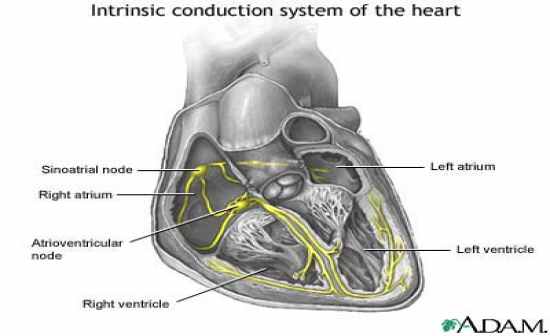Cards In This Set
| Front | Back |
|
Cardiorespiratory System
|
-A system of the body composed of the cardiovascular and respiratory system.
-2 systems (cardiovascular and respiratory) working together to provide body with oxygen and nutrients and remove waste products such as CO2 from the cells in the body. |
|
Cardiovascular System
|
-A system of the body composed of the heart, blood, and blood vessels.
-Transports blood from heart to tissues of the body. |
|
Heart
|
-Hollow muscular organ that pumps a circulation of blood through the body by means of rhytmic contraction.
-Positioned obliquely in the center of the chest (thoracic cavity) lying anteriorly (in front) to the spine and posteriorly (behind) to the sternum. -Left and right lungs lie on either side of the heart. -Adult heart is approx the size of an adult fist and weighs roughly 300 grams. |
|
Mediastinum
|
Space in the chest between the lungs that contains all the internal organs of the chest except the lungs.
|
|
Cardiac Muscle
|
-One of 3 major types of muscle, the others being skeletal and smooth msucle.
-Contains myofibrils and sarcomeres aligned side by side like skeletal muscle. -Difference is skeletal muscle is voluntary, cardiac is involuntary. |
|
Typical Resting Heart Rate
|
Between 70 and 80 beats per minue.
|
|
Sinoatrial Node
|
A specialized area of cardic tissue, located in the right atrium of the heart, which initiates the electrical impulses that determine the heart rate; often termed the pacemaker of the heart.
|
|
Atrioventricular Node
|
A small mass of specialized cardia muscle fibers, located in the wall of the right atrium of the heart, that receives heartbeat impulses from the sinoatrial node and directs them to the walls of the ventricles.
|
|
Diagram of the Conduction System of the Heart
|
 |
|
Atrium
|
-Located superior (at top) of heart, gathers blood from lungs / body.
-Right = gathersdeoxygenated from body -Left = gathers oxygenated from lungs |
|
Ventricle
|
-Bottom (inferior) chamber of heart that recives blood from atrium and forces into arteries.
-Right = deoxygenated from atrium to lungs -Left = oxygenated from atrium to body *Left ventricle has thicker walls because it pumps under higher pressure to the rest of the body. |
|
Stroke Volume
|
-The amount of blood pumped out of the heart with each contraction.
-Difference b/w ventricular end-diastolic volume and end-systolic volume. -End-Distolic (EDV) volume of ventricle before contraction. -End-Systolic (ESV) volume of residual blood in ventricle after ejection. -Typical is 120mL - 50mL, making typical Stroke Volume 70mL |
|
Heart Rate
|
The rate at which the heart pumps.
-Average resting is between 70 and 80 beats per minute. |
|
A
|
A
|



